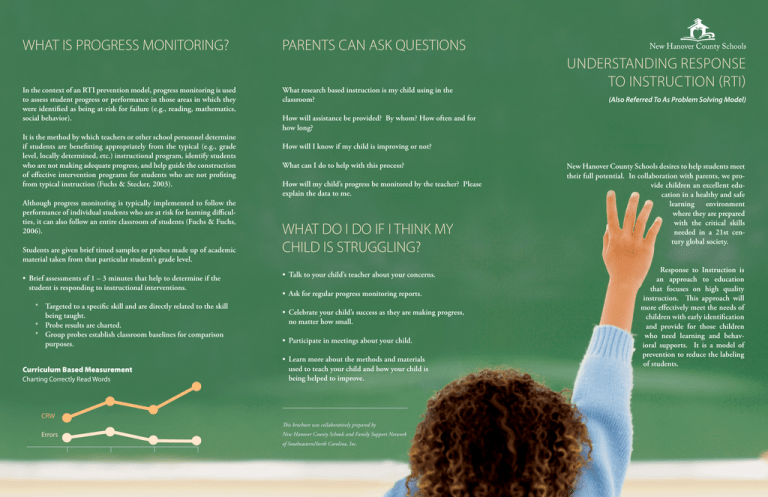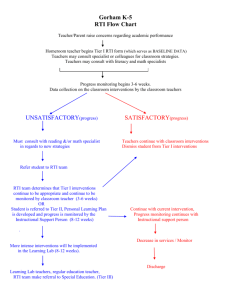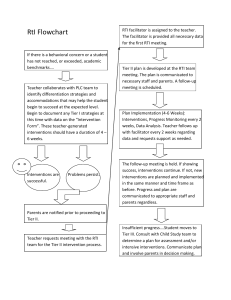WHAT IS PROGRESS MONITORING? PARENTS CAN ASK
advertisement

WHAT IS PROGRESS MONITORING? In the context of an RTI prevention model, progress monitoring is used to assess student progress or performance in those areas in which they were identified as being at-risk for failure (e.g., reading, mathematics, social behavior). It is the method by which teachers or other school personnel determine if students are benefitting appropriately from the typical (e.g., grade level, locally determined, etc.) instructional program, identify students who are not making adequate progress, and help guide the construction of effective intervention programs for students who are not profiting from typical instruction (Fuchs & Stecker, 2003). Although progress monitoring is typically implemented to follow the performance of individual students who are at risk for learning difficulties, it can also follow an entire classroom of students (Fuchs & Fuchs, 2006). Students are given brief timed samples or probes made up of academic material taken from that particular student’s grade level. • Brief assessments of 1 – 3 minutes that help to determine if the student is responding to instructional interventions. * * * Targeted to a specific skill and are directly related to the skill being taught. Probe results are charted. Group probes establish classroom baselines for comparison purposes. Curriculum Based Measurement Charting Correctly Read Words PARENTS CAN ASK QUESTIONS What research based instruction is my child using in the classroom? (Also Referred To As Problem Solving Model) How will assistance be provided? By whom? How often and for how long? How will I know if my child is improving or not? What can I do to help with this process? How will my child’s progress be monitored by the teacher? Please explain the data to me. WHAT DO I DO IF I THINK MY CHILD IS STRUGGLING? • Talk to your child’s teacher about your concerns. • Ask for regular progress monitoring reports. • Celebrate your child’s success as they are making progress, no matter how small. • Participate in meetings about your child. • Learn more about the methods and materials used to teach your child and how your child is being helped to improve. CRW This brochure was collaboratively prepared by Errors Understanding Response to Instruction (RTI) New Hanover County Schools and Family Support Network of SoutheasternNorth Carolina, Inc. New Hanover County Schools desires to help students meet their full potential. In collaboration with parents, we provide children an excellent education in a healthy and safe learning environment where they are prepared with the critical skills needed in a 21st century global society. Response to Instruction is an approach to education that focuses on high quality instruction. This approach will more effectively meet the needs of children with early identification and provide for those children who need learning and behavioral supports. It is a model of prevention to reduce the labeling of students. RTI is a three tier process that builds upon one another academic systems behavioral systems RTI model is about adopting best professional practice, insisting that we do what is best and necessary for all students in our schools, and finally, rising to the challenge of doing that which is socially just. Tier 3: Intensive, Individual Interventions Tier 3: Intensive, Individual Interventions Individual Students . Assessment-based High Intensity . Of Longer Duration Individual Students . Assessment-based High Intensity . Of Longer Duration Tier 2: Targeted Group Interventions Some Students (at-risk) . High Efficiency Rapid Response Tier 2: Targeted Group Interventions Some Students (at-risk) . High Efficiency Rapid Response Tier 1: Core Instructional Interventions Tier 1: Core Instructional Interventions All Students Preventive, Proactive Explanation of the Tiers All Settings, All Students Preventive, Proactive Tier 1: All students have access to high quality curriculum, instruction, and behavior supports in the classroom. All students are screened on a periodic basis to identify struggling learners who need additional supports. Those students who need these extra supports will get supplemental instruction during the school day in their regular classroom. Student progress is closely monitored. Tier 2: If a student does not show significant enough progress in Tier 1, then they move into Tier 2 supports. Here they are provided with increasingly intensive instruction that is matched to their specific needs. Quick and easy testing can determine exactly where the child has challenges and a plan is developed to reduce the student’s difficulty. This instruction will continue to be modified until the student begins to show success. Students showing significant progress go on with the regular classroom program. If a student’s progress information is not meeting targets, they are considered for more intensive interventions in Tier 3. Tier 3: Only about 5% of students will need this most intensive level of instruction in order to be successful. More specialized assessments and input from the parent and school team occurs. Other school members such as a psychologist, special education teacher, reading coach, etc. may become more involved with the student. All team members, including the parent, closely monitor the child’s progress and determine which steps need to occur. students students It should be noted that at any point in an RTI process, IDEA 2004 allows parents to request a formal evaluation to determine eligibility for special education. An RTI process cannot be used to deny or delay a formal evaluation for special education. If you have further questions, contact your school principal.



